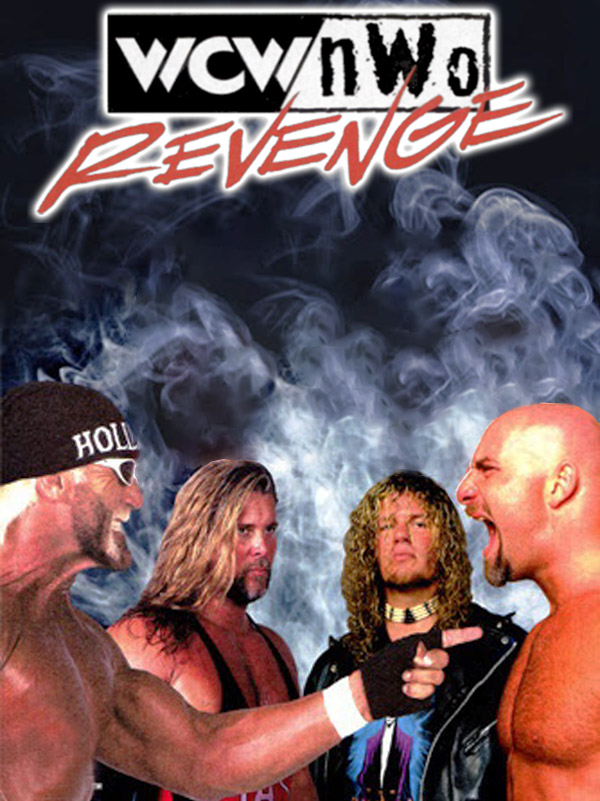For many, a mention of the “Rule of Two” conjures up images of Sith Lords wielding crimson lightsabers, but in this particular instance, it pertains to how character selection in WCW/nWo Revenge plays a pivotal role in the consistency (or lack thereof) of your opposition across repeated Tag Team tournament runs. To elaborate, in an attempt to improve my speedrun time for the Tag Team tournament within WCW/nWo Revenge, I made a change to my existing champions (the only opponent slot over which one has complete control) by installing the team of Eric Bischoff and Kevin Nash as the new belt-holders. The rationale for this move was twofold. First, as noted as a possible time save in my previous guide regarding the Kanyon’s Corner technique, Bischoff’s inclusion as the primary final opponent was due to his apparent low endurance coupled with his inability to grapple. The selection of Nash as Bischoff’s partner on the apron reduced the likelihood of a pinfall break-up, as he has one of the slowest ring entries in the game (stepping over the top rope). Additionally, I knew that his inclusion in this makeshift championship tandem would also eliminate his stock team (that features Randy Savage as his apron partner) from appearing in the tournament, which was an added bonus given his noted difficulties when it comes to performing Kanyon’s Corner. The switch paid off and yielded a near immediate improvement. However, as I continued with subsequent attempts, I noticed that the change also produced a situation that I had not yet seen, a repeating tournament ladder comprised of:
- Sting & Lex Luger
- Hollywood Hogan & Bret Hart
- The Giant & Brian Adams
- Raven & Reese
- Kidman & Riggs
- Diamond Dallas Page & Chris Benoit
- Booker T. & Stevie Ray
- Jim Neidhart & The British Bulldog
- Eric Bischoff & Kevin Nash
Now, I had owned this game for over two decades, and throughout that entire span, I had been under the apparent misconception that the Tag Team tournament opponents were always shuffled across attempts for matches one through eight, with the ninth match team (either the current champions when challenging or the prior champions when defending) being the only constant and predictable one. Needless to say, I was extremely intrigued by this turn of events. Moreover, I was determined to figure out what the triggering variable was between a Tag Team tournament with a shuffling opponent ladder versus one that remained unchanged across repeated attempts.
To start with, I compared the two most recent Tag Team tournament PBs that I had. In both runs, I had utilized the team of Kanyon and Han Zo Mon, so the ladder consistency change observed did not appear to stem directly from them. Thus, it had to be the only other factor that was within my control to change, the final opponents. In my initial PB where I had observed a shuffled opponent lineup between attempts, my final opponents were AKI Man and Dr. Frank. As noted above, my final opponents in the static opponent ladder attempts were Eric Bischoff and Kevin Nash. So, I was confronted with the question, “What was so special about Bischoff and/or Nash that would alter the manner in which my tournament opponents were selected across multiple attempts?” My journey toward that answer began by looking at the full slate of stock pairings that the game presents as your tournament opposition. Having spent so much time playing the ever shuffling version of the tournament, I had already compiled a comprehensive list of the seventeen stock tag teams (in no particular order):
- Diamond Dallas Page & Chris Benoit
- Kevin Nash & Randy Savage
- The Giant & Brian Adams
- Hollywood Hogan & Bret Hart
- Booker T. & Stevie Ray
- Meng & The Barbarian
- Disco Inferno & Alex Wright
- Kidman & Riggs
- Van Hammer & Juventud Guerrera
- Rey Mysterio Jr. & Ultimo Dragon
- La Parka & Psychosis
- Jim Neidhart & The British Bulldog
- Chris Jericho & Eddie Guerrero
- Sting & Lex Luger
- Scott Steiner & Scott Norton
- Roddy Piper & Larry Zbyszko
- Saturn & Kanyon
Of the two wrestlers that I had for final opponents, only Kevin Nash was affiliated with a stock team, so I decided to center the focus of my study on the impact that the presence of stock team characters had on the tournament ladder consistency. After testing out numerous combinations with varying configurations of stock and non-stock team wrestlers, the results led me to a fascinating conclusion. Specifically, if the number of unique stock teams represented between the four wrestlers featured in the tournament finale (both the player’s two selected wrestlers and the two preset final match opponents) is equal to two, the generated tournament ladder will be fixed across all attempts. Conversely, if the total unique stock team representation between the two final teams is zero, one, three, or four, the tournament ladder will shuffle between attempts for matches one through eight. So, the reason why my first PB setup yielded the shuffled opponent lineup was because Kanyon was the only one of the four final match participants that was affiliated with a stock team (Saturn & Kanyon). Thus, the unique stock team representation tally was one. My second PB produced a static tournament ladder across all attempts because Nash’s addition to the mix with Kanyon brought the unique stock team representation total to two.
Now, there is a major point of clarification to be made regarding the tabulation of the unique stock team total. Namely, that including two members from the same stock team (in any of the four available slots) will only count as one stock team, so for example, Roddy Piper (on a stock team, counts as one) and Glacier (not on a stock team, does not get counted) versus Meng and The Barbarian (both on the same stock team, so they only count as one) would still produce a fixed tournament ladder, since the total number of unique stock teams represented would equal two. A few more examples of fixed ladder producing configurations include:
- Kanyon and Sting vs. Lex Luger and Glacier: Only Kanyon, Sting, and Luger are on stock teams, but since Sting and Luger are from the same stock team (despite being placed on opposing teams here), they still only count as one stock team collectively. As a result, the overall unique stock team count would be two.
- Chris Jericho and Rey Mysterio Jr. vs. Jekel and Executioner: Jericho and Mysterio each represent distinct stock teams, while neither Jekel nor Executioner are on a stock team. Thus, the overall unique stock team count would be two.
- Kevin Nash and Hollywood Hogan vs. Randy Savage and Bret Hart: All four wrestlers are members of stock teams. However, while they are paired on opposing sides here, each wrestler’s stock team partner is still a part of the foursome, so the overall unique stock team count would still be just two.
Companion Video:





